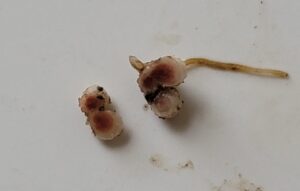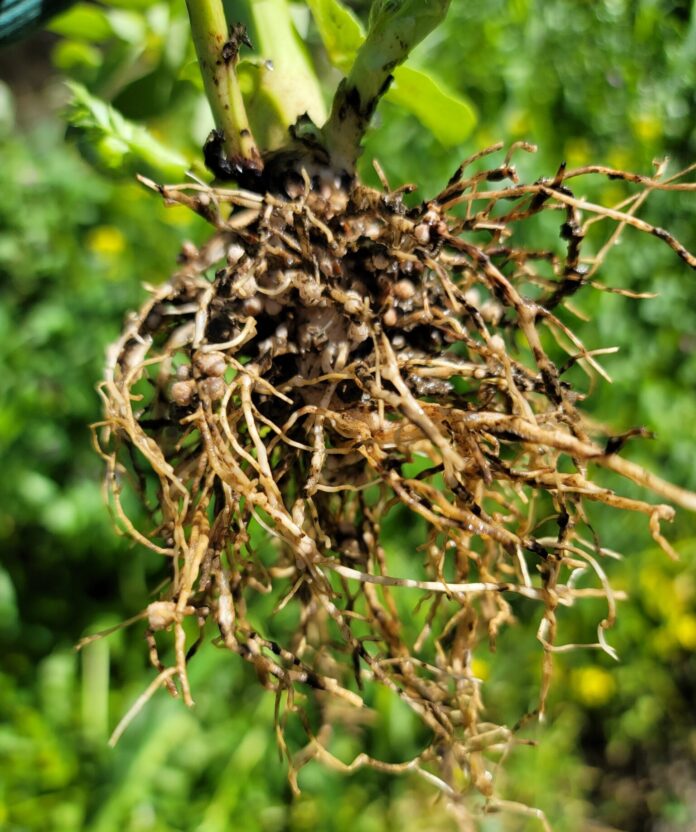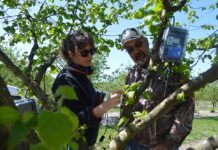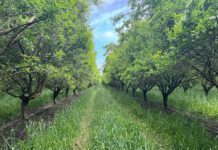Finding a balance between fertilizer costs and achieving economically acceptable yields is a grower’s yearly endeavor. Orchards require good fertilization to produce yields and maintain tree health. Nitrogen-fixing cover crops can be used to supplement fertilizer requirements and may be an economic solution if managed correctly.
Through Project Apis m.’s Seeds for Bees® program growers can experience nitrogen-fixing cover crops by receiving free or subsidized seed. The application only takes a few minutes to complete, doesn’t require the submission of any additional paperwork, and applicants need to meet just three requirements: Be located in California, be able to plant 4 or more acres of cover crop, and either be or represent a commercial grower or beekeeper. Seeds for Bees® has several select nitrogen-fixing blends available through the program.
N is critical to plant growth. This nutrient is intricately imbedded in plant systems and is critical to the formation of DNA, proteins and chlorophyl. Chlorophyl is the photosynthetic machinery of plant cells and gives leaves their iconic green color.
78% of the earth’s atmosphere is comprised of gaseous N; however, it is unavailable to plants in this form. There are many ways N can be added to the soil and made available to plants. The most common method available in nature is N fixation by bacteria. Though there are some free-living nitrogen-fixing microorganisms, much of the naturally occurring plant-available N comes from a symbiotic relationship between plants and bacteria, such as that found between legumes and rhizobia.
Legumes, also known as the bean family, can be colonized by rhizobia, a family of bacteria. When this occurs, a nodule is formed on the plant’s roots. Within the nodule, the rhizobia turn inert gaseous N (N2) into biologically available ammonia (NH3). The bacteria exchange this ammonia for nutrients and protection by the plant. As the nodules grow and mature, their interior will take on a red or pink color. This is due to the presence of leghemoglobin, a protein like the hemoglobin found in red blood cells. This protein ensures adequate amounts of oxygen are supplied to the bacteria to sustain optimal N production.
Nitrogen-fixing cover crops, like the Seeds for Bees® Nitrobuilder seed mix, can provide a measurable impact within the first year. A rule of thumb when cultivating a nitrogen-fixing cover crop is to terminate it when the legumes have reached 20% bloom. This is the sweet spot when the legumes have reached their ultimate growth but just before they’ve started investing their energy into pod formation. Percent of bloom can be determined by counting the number of open flowers on a single plant and comparing that to the number of unopened flower buds; the more plants counted, the more accurate this percentage will be. A soil sample should be taken after the cover crop biomass has decomposed to determine the amount of N and other nutrients that have been released into the soil.

Estimating Cover Crop N
If an estimate of the N present in the cover crop is needed before termination, the following method can be used. For more accurate results, it is best to take multiple samples. This system requires a premeasured area, like a 2 x 2 ft square PVC frame. Place this square over the cover crop, gently working it down to the ground. Once placed, cut the plant biomass within the square, working down to as close as possible to the ground without pulling the plants out by the root. For mixed cover crops, it’ll be necessary to separate the legumes from the rest of the cover crop species. Allow the cut biomass to dry in the sun for a few days before weighing the clippings, weigh the dried legumes separately and calculate the formula below for the legumes and the rest of the cover crop individually.
Once the weight of the dried cover crop is known, the following formula can be used to determine the total dry weight per acre. Note: 43,560 is the number of square feet in an acre.
(Dry weight x 43,560)/area sampled in square feet = total dry weight per acre
If, for example, the dry weight of the sample was 0.6 lbs. and two 2 x 2 ft square samples were taken, then (0.6 x 43,560)/8 = 3,267 lbs. per acre.
Typically, legumes contain 4% N by dry weight at flowering, which drops to 3% when pods begin to form. Nonlegumes generally contain 3% N by dry weight at flowering and 2% during seed set.
For legumes, multiply the dry weight by 0.04 to calculate the estimated pounds N per acre, and for non-legumes, multiply the dry weight by 0.03. If the example cover crop was comprised entirely of legumes, then 3,267 lbs. x 0.04 = 131.68 lbs. N per acre. If the cover crop was mixed, multiply the dry weights by their corresponding percentages and then add the results to get the total estimated N.
The final step is to calculate the amount of N which will be made available within the first year. Since the N in the cover crop is tied up within the plant matter, it will need to be broken down by soil microbes before it will become available for plant use.
If the cover crop is terminated and the residue is left on the soil surface, 40% N can be expected to be available within the first year. If the cover crop is incorporated through disking or tillage, then 50% N can be expected. Following the example from before, if the cover crop is left on the surface, approximately 53 lbs. N will be available within that year. If it were to be incorporated, then roughly 66 lbs. N will be available.
Legumes can provide surprising amounts of N, which becomes available as those plants decompose. An example would be Crimson Clover, a component of the Seeds for Bees® Annual Clover mix, which has been found to provide between 50 to 150 lbs. N per acre if growing conditions permit. Compare that to the N needs of cash crops like almonds, where approximately 68 lbs. N is required for every 1,000 pounds almond yield.
Cover Crops Provide Significant N to Orchards
With the average almond orchard producing between 2,000 to 3,000 pounds of kernels per acre, it is clear cover crops can’t provide for the entire N need of the orchard, but they can supplement a significant amount. Keep in mind that typically only half of the orchard acreage is planted into cover crops, and the trees require a little extra N for their own biological functions when planning on N from a cover crop.
With the greatest N requirements of tree crops occurring in the spring and summer, it is critical to time the cover crop around the orchard’s needs. Winter cover crops, like Seeds for Bees® mixes, are an excellent choice for California orchard crops as the cover crop can be cultivated while the orchard is dormant. If planted in the fall, cover crops can take advantage of winter rains, eliminating the need to irrigate them, be available for honeybees in late winter, and then be terminated in the spring, providing fixed N and the nutrients they scavenged over the winter to the orchard as they decompose.
Scavenged nutrients are the nutrients the cover crop took up while the plant was alive. Like all plants, cover crops use nutrients to grow and reproduce, a fact which is excellent for storing readily leached nutrients over the winter. Some nutrients are more leachable than others, such as N, sulfur and boron. These can be lost over the winter rainy season when they are washed below the root zone. Some deep-rooted cover crops can be used to retrieve some of these nutrients, but it is more effective to use cover crops to absorb nutrients before the rains carry them away. Cover crops could be like a sponge, sopping up soil nutrients and storing them until they are released after termination.
The difficulty with planning a nutrient plan around cover crops are their comparatively lower nutrient yields and seasonal fluctuation. Like all things in agriculture, the effectiveness of soil health practices is inevitably mediated by the weather and time. This requires additional management and flexibility.
Cover crops can be an economic way to supplement fertilizer costs while offering a variety of other benefits. Through Project Apis m.’s Seeds for Bees® program, growers can experiment with cover crops at little cost. Seeds for Bees® is entirely funded by donations from growers, beekeepers and corporations, making this program stackable with any government-funded opportunity.
The Seeds for Bees® application is open from April 1 to August 31. If you are interested in applying, it is advisable to do so soon as the program is becoming increasingly popular and seed supplies are limited. Learn more or access the application at projectapism.org.
References
Duiker, S., Curran, W., & Gallagher, R. (2010) Hairy Vetch as a cover crop. Penn State Extension. Hairy Vetch as a Crop Cover (psu.edu)
Jennings, J. (NA) Value of nitrogen fixation from clovers and other legumes. University of Arkansas Division of Agriculture Research and Extension. Value of Nitrogen Fixation from Clovers and Other Legumes – FSA2160 (uada.edu)
Miller, J. and Shober, A. (2021) Leachable nutrients: Sulfur, boron and nitrogen fertility in corn. University of Maryland Extension. Leachable Nutrients: Sulfur, Boron, and Nitrogen Fertility in Corn | University of Maryland Extension (umd.edu)
SARE (2024) Cover crops at work: Keeping nutrients out of waterways. Sustainable Agriculture Research and Education. Cover Crops at Work: Keeping Nutrients Out of Waterways – SARE
The Almond Board of California (2014) Nitrogen best management practices. Almond Board of California. ABC_Nitrogen_8.5x11_vmags.pdf (almonds.com)
Tripathi, D., & et al. (2014) Role of macronutrients in plant growth and accumulation: Recent advances and future prospective. Improvement of Crops in the Era of Climate Changes. Role of Macronutrients in Plant Growth and Acclimation: Recent Advances and Future Prospective | SpringerLink
University of Minnesota Extension (2021) Estimating nitrogen credits from cover crops. University of Minnesota Extension. (428) Estimating nitrogen credits from cover crops – YouTube
















